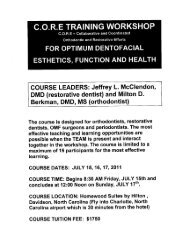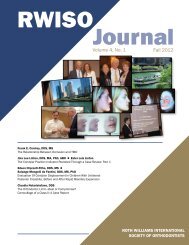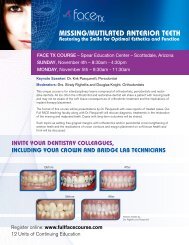2010 RWISO Journal - Roth Williams International Society of ...
2010 RWISO Journal - Roth Williams International Society of ...
2010 RWISO Journal - Roth Williams International Society of ...
You also want an ePaper? Increase the reach of your titles
YUMPU automatically turns print PDFs into web optimized ePapers that Google loves.
Figure 21 Mandibular movement after coronaplasty.<br />
Figure 21-a In the right chewing movement, both the chewing<br />
and the nonchewing sides show sufficient clearance between<br />
the upper and lower posterior teeth (blue arrows).<br />
Figure 21-b In the left chewing movement, both the chewing and<br />
the nonchewing sides show sufficient clearance (blue arrows).<br />
With coronaplasty the patient’s bite was stable, and the<br />
patient was pleased with his smile and with the overall appearance<br />
<strong>of</strong> his face (Figure 22).<br />
The abnormal tooth wear the patient demonstrated before<br />
coronaplasty was due to improper incisal guidance and<br />
canine guidance. Since tooth wear progresses much faster in<br />
the dentin layer than in enamel, his entire dentition would<br />
have become significantly shorter over the next 10 to 20<br />
years, if no intervention had taken place. The patient’s occlusion<br />
was completed with coronaplasty, and the longevity<br />
and stability <strong>of</strong> his dentition were greatly enhanced.<br />
Discussion<br />
At the present, the majority <strong>of</strong> dentists believe that teeth<br />
can successfully compensate for the loss <strong>of</strong> tissue by migration<br />
and elongation, and that these do not disturb the basic<br />
functions <strong>of</strong> the masticatory system (mastication, speech,<br />
and swallowing). 19 However, some researchers have argued<br />
that anatomical tooth form plays an important role in the<br />
proper function <strong>of</strong> the masticatory system. 17,18 Knight and<br />
et al conducted a longitudinal study on 223 orthodontically<br />
treated patients 20 years posttreatment. They found that<br />
there was a strong relationship between incisal and occlusal<br />
tooth wear during the mixed dentition and subsequent<br />
wear <strong>of</strong> the adult dentition. 20 Tooth wear that occurred during<br />
the mixed dentition in these subjects actually occurred<br />
on the permanent incisors. Even though the malocclusion<br />
was corrected, the loss <strong>of</strong> tissue due to wear in the previously<br />
affected teeth persisted. Consequently, the patients’<br />
incomplete anterior and canine guidance systems continued<br />
to influence their permanent dentition.<br />
Figure 22 Comparison <strong>of</strong> the case before and after coronaplasty.<br />
Figure 22-a Full-smile facial photograph taken after<br />
coronaplasty shows that the patient’s smile became<br />
more esthetically pleasing.<br />
Figure 22-b Lateral facial photographs taken<br />
before and after coronaplasty show little change.<br />
With regard to interferences in mandibular movement,<br />
Masatoshi and Masanori studied occlusal factors in relation<br />
to TMD in 146 young adults; they concluded that molarguided<br />
occlusion patterns were associated with a high risk<br />
<strong>of</strong> TMD. 21 All subjects with TMD had nonchewing interferences<br />
in border excursions and in tooth-dictated excursions.<br />
Without additive coronaplasty to restore the lost volume <strong>of</strong><br />
tooth material, complete elimination <strong>of</strong> interferences may<br />
not be possible, nor may it be possible to maintain the optimal<br />
health <strong>of</strong> the teeth. 16 As we saw in case 6, the teeth<br />
were too worn down to allow for adequate function, and<br />
the post-orthodontic result was an incomplete occlusion vulnerable<br />
to relapse. The patient’s TMJ symptoms would have<br />
persisted, and the attrition process would have accelerated<br />
once the dentin layer was exposed. Tooth wear that occurred<br />
while the patient was receiving treatment was unavoidable in<br />
this case. Early intervention <strong>of</strong> malocclusion in mixed denti-<br />
<strong>RWISO</strong> <strong>Journal</strong> | September <strong>2010</strong><br />
67








